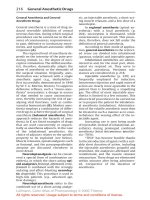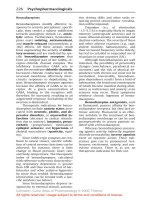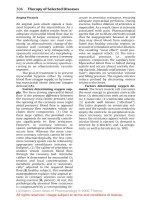Tài liệu Color Atlas of Pharmacology (Part 24): Disinfectants ppt
Bạn đang xem bản rút gọn của tài liệu. Xem và tải ngay bản đầy đủ của tài liệu tại đây (812.56 KB, 16 trang )
Disinfectants and Antiseptics
Disinfection denotes the inactivation or
killing of pathogens (protozoa, bacteria,
fungi, viruses) in the human environ-
ment. This can be achieved by chemical
or physical means; the latter will not be
discussed here. Sterilization refers to
the killing of all germs, whether patho-
genic, dormant, or nonpathogenic. Anti-
sepsis refers to the reduction by chemi-
cal agents of germ numbers on skin and
mucosal surfaces.
Agents for chemical disinfection
ideally should cause rapid, complete,
and persistent inactivation of all germs,
but at the same time exhibit low toxic-
ity (systemic toxicity, tissue irritancy,
antigenicity) and be non-deleterious to
inanimate materials. These require-
ments call for chemical properties that
may exclude each other; therefore,
compromises guided by the intended
use have to be made.
Disinfectants come from various
chemical classes, including oxidants,
halogens or halogen-releasing agents,
alcohols, aldehydes, organic acids, phe-
nols, cationic surfactants (detergents)
and formerly also heavy metals. The ba-
sic mechanisms of action involve de-
naturation of proteins, inhibition of en-
zymes, or a dehydration. Effects are de-
pendent on concentration and contact
time.
Activity spectrum. Disinfectants
inactivate bacteria (gram-positive >
gram-negative > mycobacteria), less ef-
fectively their sporal forms, and a few
(e.g., formaldehyde) are virucidal.
Applications
Skin “disinfection.” Reduction of germ
counts prior to punctures or surgical
procedures is desirable if the risk of
wound infection is to be minimized.
Useful agents include: alcohols (1- and
2-propanol; ethanol 60–90%; iodine-re-
leasing agents like polyvinylpyrrolidone
[povidone, PVP]-iodine as a depot form
of the active principle iodine, instead of
iodine tincture), cationic surfactants,
and mixtures of these. Minimal contact
times should be at least 15 s on skin are-
as with few sebaceous glands and at
least 10 min on sebaceous gland-rich
ones.
Mucosal disinfection: Germ counts
can be reduced by PVP iodine or chlor-
hexidine (contact time 2 min), although
not as effectively as on skin.
Wound disinfection can be achieved
with hydrogen peroxide (0.3%–1% solu-
tion; short, foaming action on contact
with blood and thus wound cleansing)
or with potassium permanganate
(0.0015% solution, slightly astringent),
as well as PVP iodine, chlorhexidine,
and biguanidines.
Hygienic and surgical hand disinfec-
tion: The former is required after a sus-
pected contamination, the latter before
surgical procedures. Alcohols, mixtures
of alcohols and phenols, cationic surfac-
tants, or acids are available for this pur-
pose. Admixture of other agents pro-
longs duration of action and reduces
flammability.
Disinfection of instruments: Instru-
ments that cannot be heat- or steam-
sterilized can be precleaned and then
disinfected with aldehydes and deter-
gents.
Surface (floor) disinfection employs
aldehydes combined with cationic sur-
factants and oxidants or, more rarely,
acidic or alkalizing agents.
Room disinfection: room air and
surfaces can be disinfected by spraying
or vaporizing of aldehydes, provided
that germs are freely accessible.
290 Disinfectants
Lüllmann, Color Atlas of Pharmacology © 2000 Thieme
All rights reserved. Usage subject to terms and conditions of license.
Disinfectants 291
Tissue
A. Disinfectants
Application sites Examples Active principles
1. Oxidants
2. Halogens
chlorine
sodium hypochlorite
iodine tincture
Skin
3. Alcohols
R-OH (R=C
2
-C
6
)
e. g., ethanol
isopropanol
Regular e.g., hands
Acute,
e.g., before local procedures
4. Aldehydes
e. g., formaldehyde
glutaraldehyde
5. Organic acids
e. g., lactic acid
Mucous membranes
6. Phenols
Nonhalogenated:
e. g., phenylphenol
eugenol
thymol
halogenated:
chlormethylphenol
7. Cationic
surfactants
Cationic soaps
e. g., benzalkonium
chlorhexidine
8. Heavy metal salts
Inanimate material: durable
against chemical + physical
measures
Inanimate matter:
sensitive to heat,
acids, oxidation etc.
Disinfection
of instruments
Skin disinfection
Disinfection of floors
or excrement
Disinfection
of mucous membranes
Wound disinfection
Phenols NaOCl
Cationic
surfactants
Phenols
Cationic surfactants
Alcohols
Iodine
tincture
Chlor-
hexidine
Chlor-
hexidine
Chlor-
hexidine
KMnO
4
H
2
O
2
STOP
Cationic surfactants
Aldehydes
Disinfectants do
not afford selective
inhibition of
bacteria
viruses, or fungi
e. g., hydrogen peroxide,
potassium permanganate,
peroxycarbonic acids
e. g., phenylmercury borate
Lüllmann, Color Atlas of Pharmacology © 2000 Thieme
All rights reserved. Usage subject to terms and conditions of license.
Drugs for Treating Endo- and
Ectoparasitic Infestations
Adverse hygienic conditions favor hu-
man infestation with multicellular or-
ganisms (referred to here as parasites).
Skin and hair are colonization sites for
arthropod ectoparasites, such as insects
(lice, fleas) and arachnids (mites).
Against these, insecticidal or arachnici-
dal agents, respectively, can be used.
Endoparasites invade the intestines or
even internal organs, and are mostly
members of the phyla of flatworms and
roundworms. They are combated with
anthelmintics.
Anthelmintics. As shown in the ta-
ble, the newer agents praziquantel and
mebendazole are adequate for the treat-
ment of diverse worm diseases. They
are generally well tolerated, as are the
other agents listed.
Insecticides. Whereas fleas can be
effectively dealt with by disinfection of
clothes and living quarters, lice and
mites require the topical application of
insecticides to the infested subject.
Chlorphenothane (DDT) kills in-
sects after absorption of a very small
amount, e.g., via foot contact with
sprayed surfaces (contact insecticide).
The cause of death is nervous system
damage and seizures. In humans DDT
causes acute neurotoxicity only after
absorption of very large amounts. DDT
is chemically stable and degraded in the
environment and body at extremely
slow rates. As a highly lipophilic sub-
stance, it accumulates in fat tissues.
Widespread use of DDT in pest control
has led to its accumulation in food
chains to alarming levels. For this rea-
son its use has now been banned in
many countries.
Lindane is the active γ-isomer of
hexachlorocyclohexane. It also exerts a
neurotoxic action on insects (as well as
humans). Irritation of skin or mucous
membranes may occur after topical use.
Lindane is active also against intrader-
mal mites (Sarcoptes scabiei, causative
agent of scabies), besides lice and fleas.
It is more readily degraded than DDT.
Permethrin, a synthetic pyreth-
roid, exhibits similar anti-ectoparasitic
activity and may be the drug of choice
due to its slower cutaneous absorption,
fast hydrolytic inactivation, and rapid
renal elimination.
292 Antiparasitic Agents
Worms (helminths) Anthelmintic drug of choice
Flatworms (platyhelminths)
tape worms (cestodes) praziquantel*
flukes (trematodes) e.g., Schistosoma praziquantel
species (bilharziasis)
Roundworms (nematodes)
pinworm (Enterobius vermicularis) mebendazole or pyrantel pamoate
whipworm (Trichuris trichiura) mebendazole
Ascaris lumbricoides mebendazole or pyrantel pamoate
Trichinella spiralis** mebendazole and thiabendazole
Strongyloides stercoralis thiabendazole
Hookworm (Necator americanus, and mebendazole or pyrantel pamoate
Ancylostoma duodenale) mebendazole or pyrantel pamoate
* not for ocular or spinal cord cysticercosis
** [thiabendazole: intestinal phase; mebendazole: tissue phase]
Lüllmann, Color Atlas of Pharmacology © 2000 Thieme
All rights reserved. Usage subject to terms and conditions of license.
Antiparasitic Agents 293
Flea
Damage to nervous system: convulsions, death
A. Endo- and ectoparasites: therapeutic agents
Tapeworms
e.g., beef
tapeworm
Louse
Round-
worms,
e.g.,
ascaris
Pinworm
Trichinella
larvae Scabies mite
Spasm,
injury of
integument
Praziquantel
Mebendazole
Hexachlorocyclo-
hexane (Lindane)
Chlor-
phenothane
(DDT)
Lüllmann, Color Atlas of Pharmacology © 2000 Thieme
All rights reserved. Usage subject to terms and conditions of license.
Antimalarials
The causative agents of malaria are plas-
modia, unicellular organisms belonging
to the order hemosporidia (class proto-
zoa). The infective form, the sporozoite,
is inoculated into skin capillaries when
infected female Anopheles mosquitoes
(A) suck blood from humans. The sporo-
zoites invade liver parenchymal cells
where they develop into primary tissue
schizonts. After multiple fission, these
schizonts produce numerous mero-
zoites that enter the blood. The pre-
erythrocytic stage is symptom free. In
blood, the parasite enters erythrocytes
(erythrocytic stage) where it again mul-
tiplies by schizogony, resulting in the
formation of more merozoites. Rupture
of the infected erythrocytes releases the
merozoites and pyrogens. A fever attack
ensues and more erythrocytes are in-
fected. The generation period for the
next crop of merozoites determines the
interval between fever attacks. With
Plasmodium vivax and P. ovale, there can
be a parallel multiplication in the liver
(paraerythrocytic stage). Moreover,
some sporozoites may become dormant
in the liver as “hypnozoites” before en-
tering schizogony. When the sexual
forms (gametocytes) are ingested by a
feeding mosquito, they can initiate the
sexual reproductive stage of the cycle
that results in a new generation of
transmittable sporozoites.
Different antimalarials selectively
kill the parasite’s different developmen-
tal forms. The mechanism of action is
known for some of them: pyrimetha-
mine and dapsone inhibit dihydrofolate
reductase (p. 273), as does chlorguanide
(proguanil) via its active metabolite. The
sulfonamide sulfadoxine inhibits syn-
thesis of dihydrofolic acid (p. 272). Chlo-
roquine and quinine accumulate within
the acidic vacuoles of blood schizonts
and inhibit polymerization of heme, the
latter substance being toxic for the
schizonts.
Antimalarial drug choice takes into
account tolerability and plasmodial re-
sistance.
Tolerability. The first available
antimalarial, quinine, has the smallest
therapeutic margin. All newer agents
are rather well tolerated.
Plasmodium (P.) falciparum, re-
sponsible for the most dangerous form
of malaria, is particularly prone to de-
velop drug resistance. The incidence of
resistant strains rises with increasing
frequency of drug use. Resistance has
been reported for chloroquine and also
for the combination pyrimethamine/
sulfadoxine.
Drug choice for antimalarial
chemoprophylaxis. In areas with a risk
of malaria, continuous intake of antima-
larials affords the best protection
against the disease, although not
against infection. The drug of choice is
chloroquine. Because of its slow excre-
tion (plasma t
1/2
= 3d and longer), a sin-
gle weekly dose is sufficient. In areas
with resistant P. falciparum, alternative
regimens are chloroquine plus pyri-
methamine/sulfadoxine (or proguanil,
or doxycycline), the chloroquine ana-
logue amodiaquine, as well as quinine
or the better tolerated derivative meflo-
quine (blood-schizonticidal). Agents ac-
tive against blood schizonts do not pre-
vent the (symptom-free) hepatic infec-
tion, only the disease-causing infection
of erythrocytes (“suppression therapy”).
On return from an endemic malaria re-
gion, a 2 wk course of primaquine is ad-
equate for eradication of the late hepat-
ic stages (P. vivax and P. ovale).
Protection from mosquito bites
(net, skin-covering clothes, etc.) is a
very important prophylactic measure.
Antimalarial therapy employs the
same agents and is based on the same
principles. The blood-schizonticidal
halofantrine is reserved for therapy on-
ly. The pyrimethamine-sulfadoxine
combination may be used for initial self-
treatment.
Drug resistance is accelerating in
many endemic areas; malaria vaccines
may hold the greatest hope for control
of infection.
294 Antiparasitic Drugs
Lüllmann, Color Atlas of Pharmacology © 2000 Thieme
All rights reserved. Usage subject to terms and conditions of license.
Antiparasitic Drugs 295
A. Malaria: stages of the plasmodial life cycle in the human;
h i h
Fever
Fever
Primaquine
Primaquine
Chloroquine
Quinine
Proguanil
Pyrimethamine
Fever
2 days :
Tertian malaria
Pl. vivax, Pl. ovale
3 days:
Quartan malaria
Pl. malariae
No fever
periodicity:
Pernicious malaria:
Pl. falciparum
not P. falcip.
Pl. falcip.
Hepatocyte
Primary tissue schizont
Sulfadoxine
Chloroquine
Mefloquine
Halofantrine
Quinine
Proguanil
Pyrimethamine
Merozoites
Hypnozoite
Preerythrocytic cycle
1-4 weeks
Erythrocytic cycle
Blood
schizont
Erythrocyte
Only
Pl. vivax
Pl. ovale
Gametocytes
Sporozoites
Lüllmann, Color Atlas of Pharmacology © 2000 Thieme
All rights reserved. Usage subject to terms and conditions of license.









